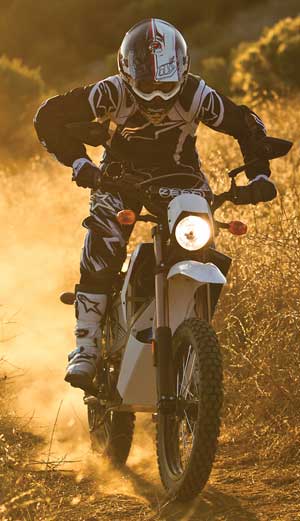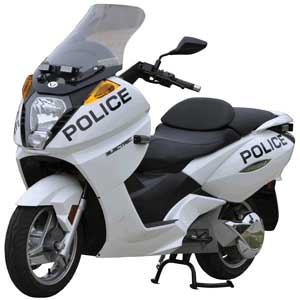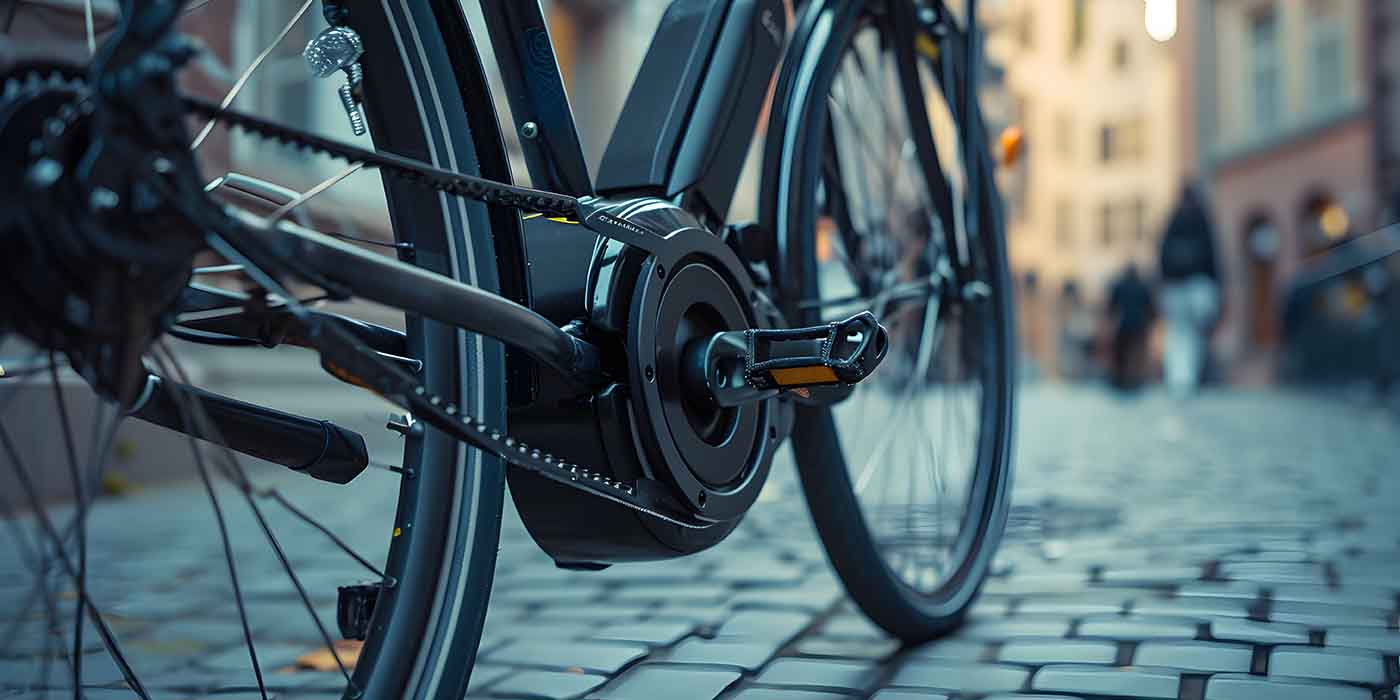 Dan Wolfson commutes about 17 miles each day to El Cajon, California. He rides his electric VX-1 motorcycle on the freeway, snakes a cord out the back door of his office, lets it charge, and rides home each night.
Dan Wolfson commutes about 17 miles each day to El Cajon, California. He rides his electric VX-1 motorcycle on the freeway, snakes a cord out the back door of his office, lets it charge, and rides home each night.
He has solar panels at home, and the office doesn’t charge him for the power. “The electricity is pretty much free,” Wolfson said.
With a top speed of 68 miles per hour, the VX-1 is faster than older electric models but still a bit of a stone on the frenetic Southern California freeways. “I ride in the right lane and watch my mirrors,” Wolfson said.
The technical advantages of electric motorcycles have been extolled by the futuristo for a long time. In 1911, Popular Mechanics featured a newly available electric bicycle, and an 1896 Cycling Life editor proclaimed that the electric bicycle offered dealers “good news for their profits.”
Floyd Clymer of Indian Motorcycles, electrician-turned-seat-manufacturer Mike Corbin and even Harley-Davidson produced electric motorcycles, all of them curiosities rather than commercially successful vehicles.
The commercial success portion of the electric equation has come to fruition, mostly in Asia. According to a report by Pikes Research, 2011 sales of scooters in Asia Pacific was 17 million units, compared to 30,000 in the rest of the world combined. And an article in the New York Times in 2010 reports China had an estimated 120 million electric bicycles on the roads.
Is it possible that Floyd, Mike and even the poor bastards who ran Harley-Davidson for AMF in the mid-1970s were onto something?
 America’s mainstream press seems to think so. “Electric Motorcycles ready for take-off” Men’s Health wrote in January 2012. Sara Carpenter of the Los Angeles Times filmed a segment in which she waxes on glowingly about the new Zero DS. Perhaps Details’ story posted March 26, 2012 summed up the spin best with the head, “Not a Motorcycle Guy? Here’s the (Electric) Bike for You.”
America’s mainstream press seems to think so. “Electric Motorcycles ready for take-off” Men’s Health wrote in January 2012. Sara Carpenter of the Los Angeles Times filmed a segment in which she waxes on glowingly about the new Zero DS. Perhaps Details’ story posted March 26, 2012 summed up the spin best with the head, “Not a Motorcycle Guy? Here’s the (Electric) Bike for You.”
The mainstream motorcycle manufacturers are dipping toes into the market. KTM built the Freeride E, an electric-powered off-road bike they are introducing this year in limited numbers in Europe. Should those few hundred or so bikes do well, the machine will come to the states in the next year or two. Honda and BMW have both announced that they are building electric bikes.
The American electric motorcycle leaders continue to be indie companies whose success at this point has been to attract press and enough backing for R&D. Industry leader Zero’s line of street, dual-sport and off-road motorcycles continues to get great press, and the spec sheet improves incrementally each year, with more horsepower and range as well as styling that is a bit less Walmart toy and a bit more biker-esque. They also offer the bikes to dealers for resale, a move that will help improve their market penetration.
Brammo’s line of street bikes is expanding, and part of their Series B round of funding in October 2011 came from Polaris. Their all-new Empulse will offer better range and performance upgraded with a six-speed transmission.
Vectrix produces a line of innovative scooters and is making an entrance into this marketplace. Founded in 1996 by a group of Lockheed-Martin engineers, the company spent 10 years developing impressive drive and throttle technology. Their electric engine and planetary drive transmission is housed in the rear hub, and one of the most efficient in the industry. The throttle includes a regenerative power feature. The rider can roll the throttle forward to reverse the electric engine. The result is the engine creates drag force that slows the motorcycle and generates power that is put back into the battery.
Vectrix went through a financial reorganization in 2009, with all the assets purchased by a battery manufacturer, Gold Peak Industries, late that year. The Vectrix line was upgraded with new lithium batteries boasting improved range and power. In addition to their two scooters — equivalent to 250cc and 50cc models — Vectrix is adding a three-wheel machine, a high-wheel 125cc equivalent scooter, and a high-performance Superbike that will go into limited production.
A mix of old and new sales and management staff determined that distribution was part of the company’s need, and a partnership with Peirspeed will allow the company to place their line of machines on motorcycle dealership floors.
“This gives us the ability to reach the motorcycle market and generate excitement in that marketplace. We are already signing dealers and intend to sign several hundred dealers this year,” said Brian Buccella, VP of sales and marketing at Vectrix. Vectrix relies on vendors around the world to move their bikes, and have had good sales in Hong Kong, the Middle East, Europe and South America.
They have also had good success selling to police departments and other fleets. The key here is that the bikes are well-suited to work in urban areas, and the total cost of ownership is extraordinarily low. Vectrix claims an annual cost of $300 per unit, compared to more than $5,000 per unit for the traditional Harley-Davidson or BMW police bikes. The NYPD has used Vectrix motorcycles since 2008, and VX-1s now patrol Central Park. Fleet sales comprise 40 percent of domestic sales for Vectrix. Brammo also sells their electric bikes to fleet customers.
The crux of the matter with electric vehicles of all stripes is range, which has been limited to this point. Early vehicles went only a few miles on a charge, and the current crop offers ranges from 30 to 100+ miles.
Wolfson’s Vectrix VX-1 is advertised to have 40 to 60 miles of range. The longest he was able to go on one charge was 45.3 miles, done on city streets. On the freeway, the bike’s range is between 25 and 28 miles. “But I’m a 200-pound guy,” he said. “If you weigh 90 pounds, you’d do better.”
Wolfson keeps an extension cord and a paperback book in the bike’s trunk. If he happens to over-extend his range — which he says has only happened a few times — he finds a gas station with an outlet, plugs in, and reads for an hour until the battery has enough charge to get him home.
The flip side of the electric coin is the race and performance bikes. A number of people have sorted out how to make electric machines fast.
Bill Dube built a dragracer dubbed Killacycle in his back bedroom, and the bike flat-out rips. His quarter-mile top speeds are just over 170 mph, and he’s done the work on a shoestring budget with minimal support. He has some competition these days, with a few others stepping in to build electric drag bikes.
On the roadrace front, the TTXGP has expanded from the inaugural race at the Isle of Mann to three regional championships in North America, Australia and Europe with bikes fielded from more than a dozen race teams. The eerily silent bikes have been developing quickly, with lap times dropping. At Infineon in 2011, the Brammo entry turned a 1:55, about 20 seconds off the pace of the Superbike race winners that year.
New manufacturers are cropping up regularly, and a number of small start-ups are building electric cruisers, sportbikes and customs. The success of the small vehicles abroad is indicative that perhaps the electric bike is finally going to come to America.
Our commuter Wolfson is a classic early adopter — he’s been commuting on electric motorcycles since 2007, and was the second guy in the country to take delivery of the first production model made by Vectrix. He had a 650 Yamaha years back, so he’s not entirely new to motorcycles. He waxes on about his machine as enthusiastically as any Harley-Davidson or Triumph rider. He loves that his bike is quiet, efficient and dirt cheap to maintain. When asked about maintenance costs, he responded with pleasure, “There are none.”
Hampton Motorsports in Southampton, New York sells a wide range of scooters, golf carts and the occasional Royal Enfield to a clientele of locals, many of whom have summer homes and cottages in the area.
“The margins on scooters are good,” said store manager Eric Mamay. “And people here just want to go from the backyard to the beach and have fun.”
He’s added a line of electric scooters from Evolve. He says it plays well with his more eco-centric line of customers. “I’ve had a lot of interest in electric vehicles, and I’ve already sold a few.”
And he already does service on the customer’s electric vehicles. “We do a lot of scooter maintenance. People still want us to grease them up, and we do a lot of storage. People bring them in for tires and brakes. And the batteries are going to go. We do golf cart service as well, and deal with people who forget to plug them in all the time.” MPN













